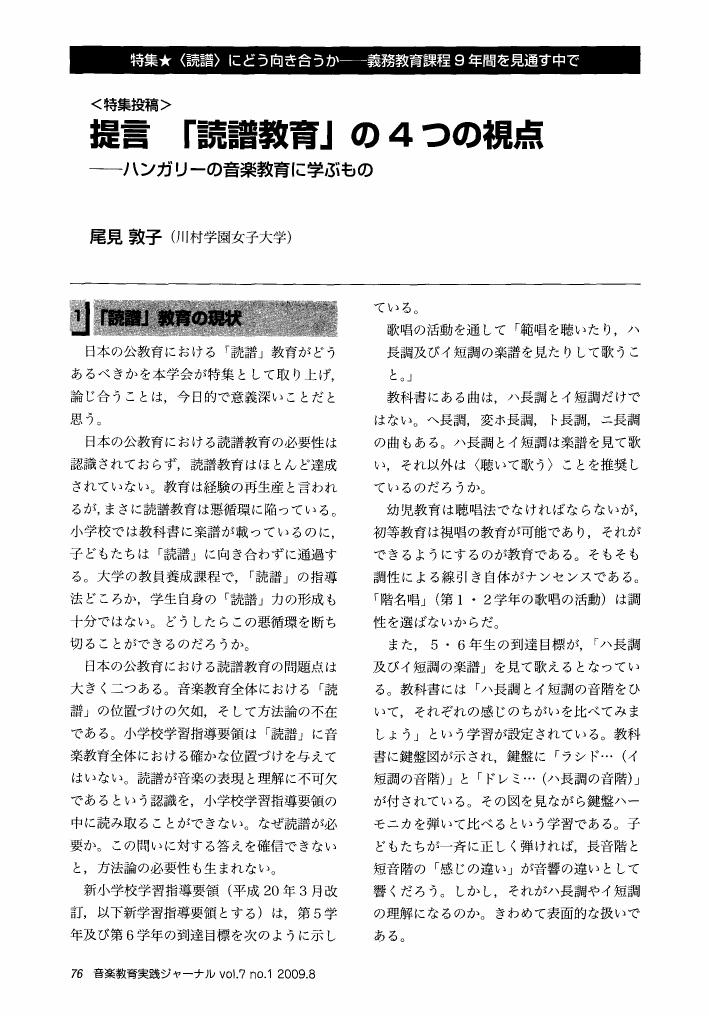3 0 0 0 OA 世界の音楽科学習指導要領を比較する (1)
- 著者
- 小川 昌文 尾見 敦子 阿波 祐子 井下 べに 永岡 都 Alison M. Reynolds
- 出版者
- 日本音楽教育学会
- 雑誌
- 音楽教育学 (ISSN:02896907)
- 巻号頁・発行日
- vol.45, no.2, pp.54-58, 2015 (Released:2017-03-22)
2 0 0 0 OA 唱法再考 ―今, 学校教育現場ですべきことは何か―
1 0 0 0 OA 学校教育の唱法問題 ─ グローバルな視点から考える ─
1 0 0 0 提言「読譜教育」の4つの視点:―ハンガリーの音楽教育に学ぶもの
- 著者
- 尾見 敦子
- 出版者
- 日本音楽教育学会
- 雑誌
- 音楽教育実践ジャーナル (ISSN:18809901)
- 巻号頁・発行日
- vol.7, no.1, pp.76-86, 2009
- 著者
- 尾見 敦子
- 出版者
- 日本音楽教育学会
- 雑誌
- 音楽教育実践ジャーナル (ISSN:18809901)
- 巻号頁・発行日
- vol.9, no.2, pp.58-66, 2012
1 0 0 0 OA なぜ音楽の授業で読譜力が養われないのか ―ハンガリーの音楽教科書が語るもの
- 著者
- 尾見 敦子
- 出版者
- 日本音楽教育学会
- 雑誌
- 音楽教育実践ジャーナル (ISSN:18809901)
- 巻号頁・発行日
- vol.9, no.2, pp.58-66, 2012 (Released:2017-05-30)
- 参考文献数
- 5
- 被引用文献数
- 2
1 0 0 0 IR コダーイ・コンセプトに基づく音楽非専攻学生のためのアカペラ合唱の教育実践
- 著者
- 尾見 敦子
- 出版者
- 川村学園女子大学図書委員会
- 雑誌
- 川村学園女子大学研究紀要 (ISSN:09186050)
- 巻号頁・発行日
- vol.24, no.2, pp.15-31, 2013
1 0 0 0 エストニアの青少年の歌と踊りの祭典
- 著者
- 尾見 敦子 蓮見 元子
- 出版者
- 川村学園女子大学子ども学研究所
- 雑誌
- 川村学園女子大学子ども学研究年報 (ISSN:24322199)
- 巻号頁・発行日
- vol.3, no.1, pp.149-165, 2018
1 0 0 0 OA 提言「読譜教育」の4つの視点
- 著者
- 尾見 敦子
- 出版者
- 日本音楽教育学会
- 雑誌
- 音楽教育実践ジャーナル (ISSN:18809901)
- 巻号頁・発行日
- vol.7, no.1, pp.76-86, 2009 (Released:2018-04-11)
- 参考文献数
- 9
1 0 0 0 OA わが「指揮者」人生はジェンダーを超えて
- 著者
- 松尾 葉子 小中 慶子 岡部 芳広 尾見 敦子
- 出版者
- 日本音楽教育学会
- 雑誌
- 音楽教育実践ジャーナル (ISSN:18809901)
- 巻号頁・発行日
- vol.11, no.1, pp.6-25, 2013 (Released:2017-05-30)
- 著者
- 尾見 敦子
- 出版者
- 川村学園女子大学
- 雑誌
- 川村学園女子大学研究紀要 (ISSN:09186050)
- 巻号頁・発行日
- vol.5, no.2, pp.61-76, 1994
Children sing their original song-like sounds more often than has been thought. Their singing extends from uttering music-like sounds to reproducing prelearned songs. The aim of my study is to explain the process of children's sound-organizing behavior and to explore the origin of their musical behavior. I define spontaneous singing behavior as follows : sound-organizing behavior with voiced sounds, which spontaneously starts and ends. I'm excluding mere reproduction of prelearned songs. I'm using data from children 2 to 4 years of age. I classified singing behavior into four types, not from the viewpoint of sound, but from the viewpoint of the motive of singing and content of the song. A child sings a message because he wants to communicate ("Message Song"); he sings an imaginative story as he wants to put himself in an imaginative play ("Story Song"); he sings about some emotion as he wants to express this emotion ("Keyword Song"); or he sings the sound itself as he wants to enjoy sound-formation ("Syllable Song"). Their improvisational songs are usually well-organized like music is. Each song has a form. Songs are produced from component to unit, and to phrase. Language is the predominant factor in each stage. Various devices, such as "rise and fall of pitch", "syllable manipulation", etc. work as the sound-forming rules. Another musical device for song-production is "to borrow prelearned songs". I believe that it is important for educators to incorporate this spontaneous musical behavior into their formal music education.Children sing their original song-like sounds more often than has been thought. Their singing extends from uttering music-like sounds to reproducing prelearned songs. The aim of my study is to explain the process of children's sound-organizing behavior and to explore the origin of their musical behavior. I define spontaneous singing behavior as follows : sound-organizing behavior with voiced sounds, which spontaneously starts and ends. I'm excluding mere reproduction of prelearned songs. I'm using data from children 2 to 4 years of age. I classified singing behavior into four types, not from the viewpoint of sound, but from the viewpoint of the motive of singing and content of the song. A child sings a message because he wants to communicate ("Message Song"); he sings an imaginative story as he wants to put himself in an imaginative play ("Story Song"); he sings about some emotion as he wants to express this emotion ("Keyword Song"); or he sings the sound itself as he wants to enjoy sound-formation ("Syllable Song"). Their improvisational songs are usually well-organized like music is. Each song has a form. Songs are produced from component to unit, and to phrase. Language is the predominant factor in each stage. Various devices, such as "rise and fall of pitch", "syllable manipulation", etc. work as the sound-forming rules. Another musical device for song-production is "to borrow prelearned songs". I believe that it is important for educators to incorporate this spontaneous musical behavior into their formal music education.






